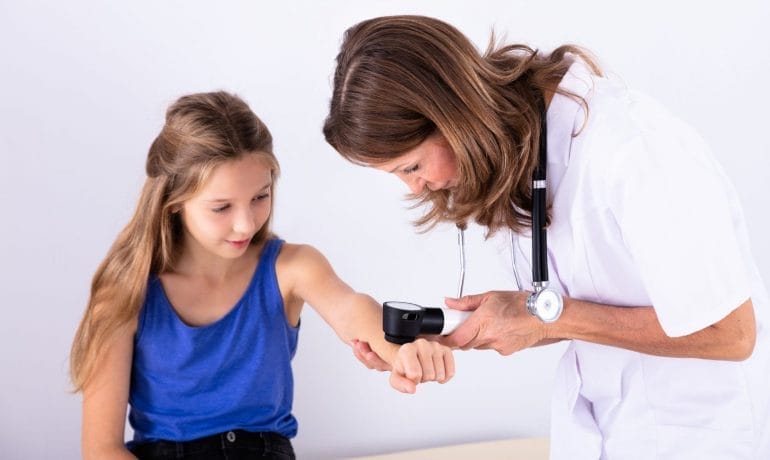When your child woke up this morning with a strange rash spreading across their arm, you might’ve felt a surge of panic. But don’t fret, you’re not alone. Pediatric dermatology is a complex field, often leaving even seasoned professionals perplexed due to the myriad skin conditions children can develop.
From common issues like eczema and acne to rare disorders that even seasoned doctors have to look up, there’s a lot to unfold. If you’ve ever wondered about the depth and breadth of this specialty, you’re on the brink of a fascinating journey.
Curious to find out more?
Understanding Pediatric Skin Disorders
When it comes to pediatric skin disorders, understanding how they present differently based on skin tones is crucial, highlighting the need for diverse representation in medical images. Skin conditions can display uniquely in children, and as someone interested in serving this demographic, it’s vital to recognize these variations.
Pediatric dermatologists are trained specifically in diagnosing these conditions. They consider factors like age, skin type, and severity when customizing treatment plans. You can trust their expertise because they’re committed to prescribing safe and effective medications, specially formulated for children’s sensitive skin. While they monitor for potential side effects, your role in monitoring your child’s skin condition is equally important.
Moreover, you play an essential part in managing pediatric skin disorders through daily routines. Dermatologists will provide guidance on skin care routines and sun protection. They’ll also educate you, helping you better understand your child’s skin condition and how to manage it. Remember, your role in your child’s skin health is crucial.
With expert help, you can navigate the complexities of pediatric dermatology with confidence and care.
Common Childhood Skin Conditions
Often, children encounter a variety of skin conditions, ranging from harmless umbilical hernias to the more peculiar eczema coxsackium, caused by the Coxsackie virus. As caretakers, it’s essential to promote healthy skin and understand these common conditions.
Umbilical hernias, prevalent in infants and young children, are typically painless and harmless. However, severe cases may require surgical intervention.
On the other hand, eczema coxsackium presents as raised reddish bumps, usually on the third finger.
Another condition, Granuloma annulare, manifests as firm bumps arranged in rings, common on the hands and fingers. Fortunately, it often resolves itself without treatment.
Similarly, Gianotti-Crosti syndrome, characterized by erythematous papules on the shins, usually disappears within a few weeks. Common in children between 6 months and 12 years, it’s an issue you’ll likely encounter.
Lastly, dermal melanocytosis, a flat blue-grey birthmark on the lower spine, is common in those with darker skin tones. It’s harmless and may fade as the child grows.
Understanding these conditions will equip you to better serve and assure the families you interact with, nurturing healthy skin in our young ones.
Role of Pediatric Dermatology
As you navigate the world of children’s skin health, the role of pediatric dermatologists becomes crucial, as they’re trained to diagnose and treat a wide array of skin conditions unique to children. Their expertise spans the range of skin conditions, from common to complex, and they’re equipped to provide personalized treatment plans for each child.
Pediatric dermatologists take into account your child’s age, skin type, and the severity of the condition. They prescribe safe and effective medications specifically formulated for your child’s sensitive skin, always prioritizing safety and managing potential side effects.
Their guidance extends beyond treatment. They’ll educate you on daily skin care routines, suitable bathing techniques, and ways to prevent skin irritation. Moreover, they’ll emphasize the importance of sun safety, detailing the right use of sunscreens, the need for protective clothing, and sun avoidance measures.
Your child’s skin health is their priority. Through regular skin checks, they strive for early detection of skin cancer, underscoring the essential role of ongoing vigilance in skin care. Indeed, the role of pediatric dermatologists is invaluable in safeguarding your child’s skin health.
Allergy Testing in Dermatology
Building on the subject of pediatric dermatology, let’s explore the crucial role of allergy testing in this field.
Allergy testing helps identify specific allergens that may trigger skin reactions in your pediatric patients. The process is instrumental in diagnosing skin conditions like atopic dermatitis, contact dermatitis, and urticaria.
Certain testing methods, such as patch testing, skin prick testing, and blood tests for specific IgE antibodies, are commonly used in dermatology. They’re vital tools for determining potential allergens contributing to chronic or recurrent skin issues. By knowing what irritants to avoid, you can better manage your young patients’ skin health, considering their unique skin type.
Remember, every child’s skin type is different and may react uniquely to various allergens. This fact further emphasizes the importance of allergy testing in providing personalized care.
Incorporating allergy testing into your practice not only helps diagnose conditions but also steers comprehensive management and prevention strategies.
As someone committed to serving others, especially children, understanding the importance of allergy testing in dermatology can significantly enhance the care you provide. It’s one more way you can help your patients enjoy healthier, happier lives.
Advances in Pediatric Skin Care
While caring for your pediatric patients, it’s crucial to stay updated on the latest advances in pediatric skin care. This encompasses individualized, effective, and safe treatment plans based on factors like age, skin type, and condition severity. Pediatric dermatologists are continually trained to diagnose and treat a broad range of skin conditions, including hair loss, with expertise and precision.
The key to successful management of these conditions is timely and accurate diagnosis. This not only ensures proper treatment but also mitigates potential complications. Safe and effective medications are prescribed that are specially formulated for children’s sensitive skin. Any potential side effects are closely monitored and managed, often in collaboration with other healthcare professionals to optimize the treatment outcomes.
Additionally, guidance on skin care routines, sun protection, and product recommendations is provided. Maintaining a consistent skin care routine is emphasized, as is sun safety. The ultimate goal is to provide comprehensive, effective, and safe skin care to your pediatric patients. Staying informed about the latest advancements in pediatric dermatology allows you to offer the best possible care.
Frequently Asked Questions
What Is the Required Educational Background and Training for a Pediatric Dermatologist?
You’ll need a medical degree, a completed dermatology residency, and additional fellowship training in pediatric dermatology to become a pediatric dermatologist. It’s a rigorous but rewarding path in the field of Dermatologist Selection.
How Can I Determine if My Child’s Skin Condition Requires a Visit to a Pediatric Dermatologist?
You’re the first line of defense. If your child’s skin changes, showing signs like persistent rashes or reactions suggesting skin allergies, it’s time to consult a pediatric dermatologist for a professional evaluation.
Are There Any Specific Lifestyle or Dietary Changes That Can Help Improve My Child’s Skin Condition?
Yes, certain dietary changes can enhance your child’s skin health. The nutritional impact of a balanced diet, rich in fruits, vegetables, and healthy fats, can’t be underestimated in improving skin conditions.
What Is the Role of Genetics in Pediatric Skin Disorders?
Genetics play a crucial role in pediatric skin disorders. Genetic testing can reveal inherited skin conditions. Your child’s skin issues aren’t just skin-deep; they’re written in their DNA, impacting their overall health.
Can the Environment or Climate Affect My Child’s Skin Condition?
Yes, the environment or climate can indeed impact your child’s skin condition. Seasonal impacts, like dry winter air or humid summers, can exacerbate existing conditions or trigger new ones. It’s always important to adapt skincare routines accordingly.
Conclusion
In conclusion, Skin Deep empowers you with information on pediatric dermatology.
You’ve explored common skin conditions and the pivotal role pediatric dermatology plays.
You’ve delved into allergy testing and the latest in skin care.
Remember, knowledge is power.
Whether you’re a concerned parent or a medical professional, Skin Deep provides you with the tools to understand, diagnose, and manage skin conditions, giving you a new sense of confidence and control.



















